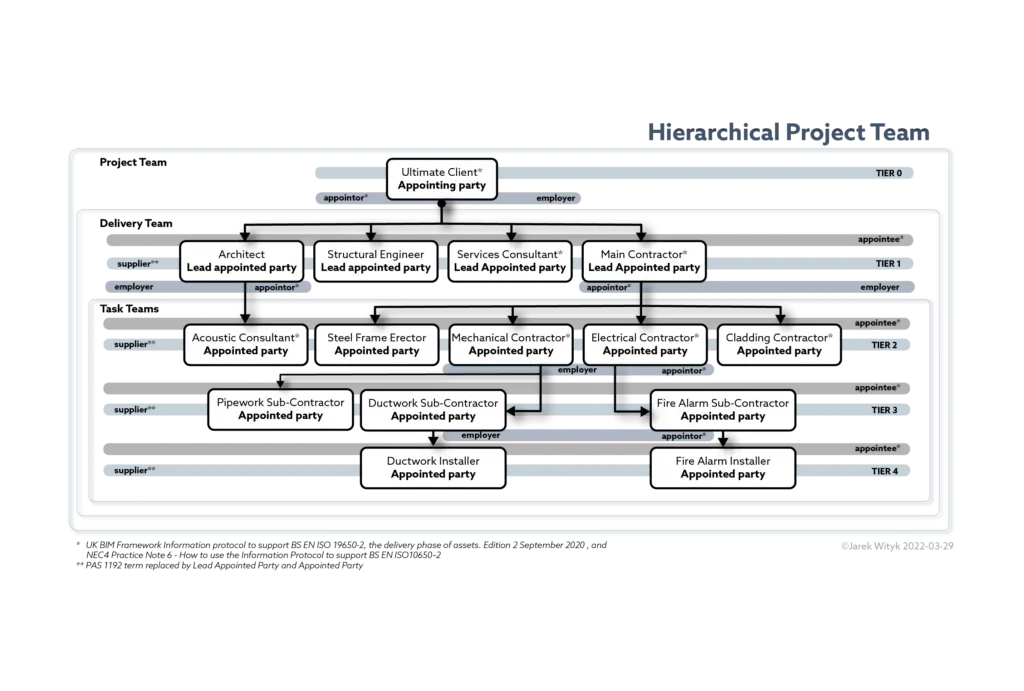Revit Guides
Data Management
Dictionary
The use of terms such as Lead Appointed Party, Appointed Party and Task Team in lieu of terms: employer, supplier, contractor and subcontractor, require clarification to become legally binding.
The meaning of BS EN ISO 19650 framework terminology included in Exchange Information Requirement (EIR) or BIM Execution Plan (BEP) and other framework documents depends on the position in the project structure.
The terms appointing party, appointed party and lead appointed party are not commonly used in contract law. Instead, terms appointor and appointee are used. To establish if a specific party is an Appointee or the Appointor, it is necessary to determine where the party sits in the supply chain. For example, the Lead Appointed Party will be the:
- Appointee in the Tier 1 contract, i.e., Appointing Party and Lead Appointed Party, and
- Appointor in the sub-contract, i.e., between Lead Appointed Party and Appointed Party
The implication of the terminology meaning and position within the supply chain is shown in Figure 1

Figure 1 – Hierarchical Project Team
UK BIM Alliance Information protocol
The UK BIM Alliance Information protocol published to support BS EN ISO 19650-2 the delivery phase of assets (in Table 1 referred to as ‘Framework’) recognised the need to incorporate new terms used in contract law, namely: ‘Appointor’ and ‘Appointee’. The meaning of the terms in relation to the ISO 19650 Framework is shown in Table 1
Table 1 – Framework terms’ Appointor’ and ‘Appointee’ [1]
| Framework Term | ISO 19650 Term | meaning |
| Appointor | Appointing Party | the party carrying out the appointment for this contract/appointment |
Example: Client appointing the Lead Appointed Party or the Lead Appointed Party appointing the Sub Contractor (Task Team/Appointed Party)
| Framework Term | ISO 19650 Term | meaning |
| Appointee | Lead Appointed party, or Appointed Party | party being appointed |
Example: the Tier 1 appointed by the Client or Task Team sub-contractor appointed by Tier 1
NEC Professional Service Contract (PSC)
Using a traditional contract arrangement where a client engages a lead consultant to design the works under an NEC Professional Service Contract (PSC), and the main contractor to construct the works under an Engineering and Construction Contract (ECC), with the subsequent teams engaged under the NEC Professional Service Subcontract (PSS) or NEC Engineering and Construction Subcontract (ECS) the Parties would fulfil the roles depicted in the UK BIM Framework Information protocol as shown in Table 2
Table 2 – Roles in NEC context [2]
| NEC Contract | Role | Function |
| PSC | Client | Appointing Party |
| ECC | Client | Appointing Party |
| PSC | Consultant | Lead Appointed Party |
| PSS | Consultant | Appointor |
| ECS | Contractor | Appointor |
| ECC | Contractor | Lead Appointed Party |
| ECC | Subcontractor | Appointed Party |
| PSC | Subcontractor | Appointed Party |
| PSS | Subcontractor | Appointee |
| PSS | Subcontractor | Appointor |
Further guidance has been published to clarify the meaning of terminology included in the UK BIM Alliance Information Protocol, edition 1 (in Table 3 referred to as ‘Protocol’) and equivalent ECC terms. The use of ECC contract with the support of UK BIM Alliance Information Protocol can be used to support the delivery phase of assets with NEC4 Contract
Table 3 – Protocol and ECC terms [3]
| Protocol terms | ECC terms |
| Material | Project Information (if provided by the Contractor) |
| Federated Information Model | Information Model |
| Lead Appointed Party | Information Provider |
| Appointor | Information Provider |
| Appointee | Information Provider |
| BIM Execution Plan | Information Execution Plan |
| Works | works |
Each Lead Appointed Party will be responsible for a Delivery Team comprising those Subcontractors or suppliers it appoints and who contribute to the Information Model. [4]
To summarise
The dependent terminology’s meaning remains ambiguous until determined by an appropriate legally binding Contract aligned with Exchange Information Requirements (EIR) established by the Appointing Party. Project-specific clarification and correct cross-referencing shall be included as necessary to add clarity. Furthermore, the use of a single suite of Contract across all levels of the project supply chain is preferred as it supports consistency of the legal obligations and terminology throughout the whole project team supporting accountability. The idea was introduced by Sir Michael Lathan more than twenty-six years ago in ‘Constructing the Team’, where the use of bespoke contracts or varying sets of contractual arrangements for the sub-appointments has been discouraged. [5]
[1] UK BIM Framework, “Information protocol to support BS EN ISO 19650-2 the delivery phase of assets,” May 2020. Accessed: Feb. 06, 2021. [Online].
[2] NEC, “Amendments to Y(UK)1 – Alliance Contract (ALC),” Oct. 2020. Accessed: Feb. 06, 2021. [Online].
[3] A. von Schwan and E. Dickson, “BIM-used copyright: Dealing with emerging technologies in construction ,” Bryan Cave Leighton Paisner LLP, Dec. 03, 2020. (accessed Feb. 06, 2021).
[4] British Standards Institution, BS EN ISO 19650-2:2018 Organization and digitization of information about buildings and civil engineering works, including building information modelling (BIM) – Information management using building information modelling Part 2: Delivery phase of the assets. 2018.
[5] M. Latham, “CONSTRUCTING THE TEAM Joint Review of Procurement and Contractual Arrangements in the United Kingdom Construction Industry Final Report,” 1994. Accessed: Dec. 31, 2020. [Online].

